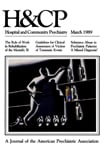Urban Psychiatric Commitments: Disability and Dangerous Behavior of Black and White Recent Admissions
Abstract
Nationally black patients are overrepresented in public psychiatric institutions and are more likely than white patients to be committed involuntarily. This study of patients from 12 treatment units in the Chicago area, where these patterns were also true, compared the functioning of 227 acute admissions grouped by race (white or black) and admission status (voluntary or involuntary). Patients were assessed by highly trained independent observers using objective measures of dangerous behavior and disability levels, the relevant classes of functioning based on common principies underlying commitment statutes. No evidence was found that racial bias and discrimination in commitment and retention decisions would account for the overrepresentation of blacks among involuntary commitments to public institutions. Rather, the same factors that account for the overrepresentation of blacks compared with whites among all admissions may also explain their overrepresentation among the involuntarily confined. Changes in treatment programming and assessment practices are suggested.
Access content
To read the fulltext, please use one of the options below to sign in or purchase access.- Personal login
- Institutional Login
- Sign in via OpenAthens
- Register for access
-
Please login/register if you wish to pair your device and check access availability.
Not a subscriber?
PsychiatryOnline subscription options offer access to the DSM-5 library, books, journals, CME, and patient resources. This all-in-one virtual library provides psychiatrists and mental health professionals with key resources for diagnosis, treatment, research, and professional development.
Need more help? PsychiatryOnline Customer Service may be reached by emailing [email protected] or by calling 800-368-5777 (in the U.S.) or 703-907-7322 (outside the U.S.).



